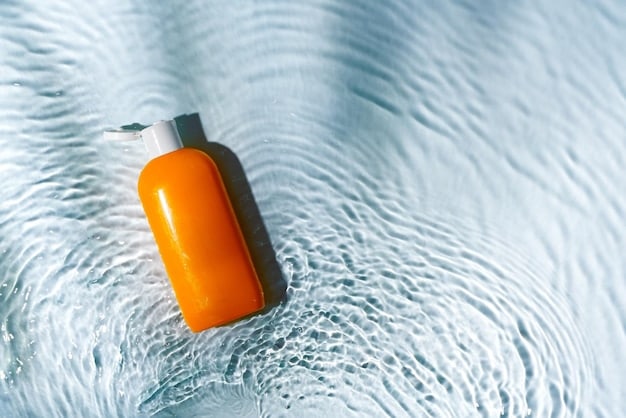Sunscreen Expiration Dates: How to Tell if Your Protection is Still Valid in 2025

Anúncios
When assessing the validity of your sunscreen, prioritize checking the expiration date printed on the packaging, as proper storage and avoiding extreme temperatures are crucial for maintaining its efficacy and protection against UV radiation.
As we navigate through 2025, a critical question often surfaces about our skincare routines: are our sunscreens still providing the protection they promise? Understanding Sunscreen Expiration Dates: How to Tell if Your Protection is Still Valid in 2025 is far more than a minor detail; it’s a fundamental aspect of sun safety that directly impacts your skin’s health and your overall well-being. This guide delves into the nuances of sunscreen longevity, efficacy, and safe usage, ensuring you’re genuinely protected under the sun.
Anúncios
The Science Behind Sunscreen Stability
Sunscreen isn’t merely a lotion; it’s a meticulously formulated product designed to create a protective barrier against harmful ultraviolet (UV) radiation. Understanding its stability is crucial for ensuring its effectiveness. Active ingredients, whether mineral (like zinc oxide and titanium dioxide) or chemical (such as oxybenzone and avobenzone), are engineered to perform specific functions: reflecting, scattering, or absorbing UV rays. Over time, however, these ingredients can degrade, compromising their ability to shield your skin. This degradation is influenced by several factors, including exposure to heat, light, and air, which can break down the molecular structure of the active compounds.
Active Ingredients and Their Lifespan
Many sunscreens contain a blend of active ingredients, each with a different stability profile. Mineral sunscreens, typically formulated with zinc oxide and titanium dioxide, are generally considered more stable over time because their mode of action is physical – they create a physical barrier on the skin. These metallic oxides are less prone to chemical degradation from environmental factors. In contrast, chemical sunscreens absorb UV radiation and convert it into heat, a process that can lead to the breakdown of their active components. For instance, avobenzone, a common UVA filter, is known for its photounstability, meaning it can break down rapidly when exposed to sunlight. Manufacturers often include stabilizers in their formulations to mitigate this issue, but their effectiveness can diminish over time.
The formulation itself plays a significant role in determining a sunscreen’s stability. Emulsifiers, preservatives, and antioxidants are added not only to create a pleasant texture and prevent microbial growth but also to help maintain the integrity of the active ingredients. A well-formulated sunscreen will be designed to withstand certain environmental stresses, but it’s not immune to the passage of time or improper storage. The interaction between various ingredients can also affect stability; for example, some ingredients might accelerate the degradation of others, while some can enhance overall stability and performance. Therefore, trusting the manufacturer’s specified expiration date is paramount, as it accounts for these complex interactions.
Anúncios

Factors Accelerating Degradation
The way you store your sunscreen can significantly impact its shelf life. Exposure to extreme temperatures, both hot and cold, is particularly detrimental. Storing sunscreen in a hot car, by the pool in direct sunlight, or in a very cold environment can cause the emulsion to separate, altering its texture and potentially rendering the active ingredients ineffective. Sunlight exposure, even when the bottle is closed, can also accelerate the degradation of light-sensitive ingredients. Air exposure, often through leaving the cap off or frequent opening and closing, can introduce oxygen, which can oxidize and degrade certain active compounds. The consistent exposure to these elements can lead to a noticeable change in the product’s consistency, color, or smell, signaling that its protective properties may be compromised.
- High Temperatures: Accelerates chemical reactions, breaking down active ingredients and destabilizing emulsions.
- Direct Sunlight: UV radiation can degrade light-sensitive chemical filters and cause product separation.
- Air Exposure: Oxidation can occur, particularly with certain active ingredients and preservatives, reducing efficacy.
- Contamination: Introducing bacteria from fingers can reduce preservative effectiveness and spoil the product.
Despite all the scientific advancements in sunscreen formulation, an expired product should generally not be relied upon for adequate UV protection. The changes that occur in an expired sunscreen might not always be visible to the naked eye. While a separated or discolored product is an obvious sign, a seemingly normal-looking sunscreen could still have compromised active ingredients. This invisible alteration means that relying on an expired product could leave your skin vulnerable to sun damage, leading to sunburns, premature aging, and an increased risk of skin cancer. Always err on the side of caution and replace any sunscreen past its expiration date or showing signs of degradation.
Decoding the Expiration Date: Where to Look
The expiration date on your sunscreen bottle is not an arbitrary number but a carefully determined guideline from the manufacturer, based on rigorous stability testing. The U.S. Food and Drug Administration (FDA) mandates that all sunscreens must feature an expiration date unless the manufacturer can prove its stability for at least three years. This means that if no date is present, the sunscreen is generally considered effective for up to three years from the purchase date, provided it has been stored correctly. However, a visible expiration date removes any guesswork, offering a clear benchmark for when the product’s efficacy can no longer be guaranteed.
Understanding “EXP” and Batch Codes
Typically, the expiration date is clearly marked as “EXP” followed by a month and year (e.g., “EXP 03/2025” for March 2025) or as “Best By.” This date signifies the last day the manufacturer guarantees the product’s full potency and safety. It’s usually found on the bottom of the bottle, on the crimped seam of a tube, or printed directly on the label. Sometimes, particularly in European markets, you might see a “Period After Opening” (PAO) symbol, which looks like an open jar with a number followed by an “M” (e.g., “12M”). This indicates how many months the product remains good after it has been opened, irrespective of the printed expiration date. However, this is less common for sunscreens, as their stability is more critical to their primary function.
Batch codes are another common marking, often confusing consumers who mistake them for expiration dates. These are internal codes used by manufacturers for tracking production batches, quality control, and recall purposes. A batch code rarely provides consumer-facing information about expiry, although some online tools or manufacturer websites might allow you to decode them to find a manufacturing date. However, for the average consumer, relying on the clearly marked “EXP” date is the most straightforward and reliable method to ascertain product validity. If no “EXP” date is present, the default three-year rule applies, but proactive replacement habits are always advisable for peace of mind and optimal protection, especially for a product as crucial as sunscreen.
No Date? What to Do
If your sunscreen bottle doesn’t have an explicit expiration date, the general rule of thumb, as per FDA guidelines, is to consider it effective for up to three years from the date of purchase. This assumes the product has been stored under ideal conditions, away from extreme heat, cold, and direct sunlight. However, relying solely on this three-year guideline can be risky, especially since it’s hard to precisely recall the exact date of purchase for every bottle of sunscreen you own. Many consumers err on the side of caution, opting to replace sunscreens annually, particularly before the peak sun exposure seasons.
To avoid uncertainty, it’s a good practice to write the purchase date directly on the bottom of the sunscreen bottle with a permanent marker. This small step can provide a helpful reference point. Moreover, pay close attention to any changes in the product’s consistency, smell, or color. Even if the sunscreen is within the three-year window, visible signs of degradation indicate that it may no longer be effective. For example, if the lotion has separated into oily and watery phases, if it smells unusually sour or off, or if its color has changed significantly, these are clear indicators that the product is compromised and should be discarded. When in doubt, it’s always safer to replace your sunscreen rather than risk inadequate protection from the sun’s damaging rays.
Signs Your Sunscreen Has Gone Bad (Beyond the Date)
While the expiration date offers a definitive guideline, sunscreens can sometimes degrade before their “official” expiry, particularly if they haven’t been stored correctly. Recognizing these physical and sensory cues is crucial for ensuring your sun protection remains robust. A seemingly minor change in appearance or texture can signify a significant drop in efficacy, leaving your skin unknowingly vulnerable to harmful UV radiation. Paying attention to these subtle but important indicators can save you from a nasty sunburn and potential long-term skin damage.
A Change in Texture or Consistency
One of the most common and visible signs of degraded sunscreen is an alteration in its texture. Sunscreen is an emulsion, meaning it’s a stable mixture of oil and water components. Over time, or with exposure to unsuitable conditions (like extreme heat), this emulsion can break down, causing the oil and water to separate. You might notice the lotion becoming unusually runny, watery, or, conversely, thick and clumpy. Sometimes, shaking the bottle might temporarily recombine the layers, but if they separate again quickly, it’s a strong indicator of degradation. The smooth, uniform consistency that ensures even application and proper spread of active ingredients is essential for effective protection.
- Separation: Product separates into distinct oily and watery layers, often visible even when shaken.
- Clumpiness: Formation of lumps or a grainy texture, indicating a breakdown of the formula.
- Unusual Thickness or Thinness: The product no longer flows or squeezes from the container as it originally did.
Beyond separation, the sunscreen might develop a grainy, lumpy, or curdled appearance, which indicates that the ingredients within the formula are no longer properly suspended. When the texture is compromised, it becomes difficult to apply the sunscreen evenly across the skin. Uneven application means inconsistent coverage, which can leave certain areas unprotected or under-protected, increasing the risk of sunburn in those spots. Therefore, if your sunscreen no longer boasts its original smooth and homogenous consistency, it is best to discontinue use and replace it, prioritizing consistent, reliable coverage for genuine sun safety, as a compromised texture directly translates to compromised protection.
Unusual Odor or Discoloration
Another clear indicator that your sunscreen may have expired or gone bad is a noticeable change in its smell or color. Sunscreens, especially those without added fragrances, generally have a mild, often neutral scent. If you detect a strong, sour, metallic, or otherwise “off” odor, it suggests that the chemical components within the formula have degraded or that the product has been contaminated. This chemical breakdown can occur due to exposure to heat, light, or air, leading to volatile compounds that produce unpleasant smells. An altered odor is often one of the first sensory clues that a product is no longer stable or effective, even if other physical changes are not yet apparent.
Similarly, a change in the sunscreen’s color can be a red flag. Most sunscreens are white or off-white. If yours has turned yellow, brown, or developed any unusual tint, it typically signals chemical oxidation of the ingredients. Active ingredients, especially certain chemical filters, and inactive ingredients like antioxidants or preservatives, can oxidize when exposed to air and light, leading to a visible color shift. While slight variations in color might occur between batches, a drastic or sudden change often indicates that the product’s protective integrity has been compromised. Both unusual odors and discolorations are strong indicators that your sunscreen is past its prime and should be replaced to ensure genuine and reliable sun protection without any compromise.
The Dangers of Using Expired Sunscreen
Using expired sunscreen might seem harmless, a “better than nothing” approach. However, this assumption is dangerously flawed. The primary risk of applying a product past its prime is a significant reduction in its efficacy, meaning it can no longer provide the advertised level of UV protection. This compromise in protection sets the stage for a cascade of negative effects on your skin, ranging from immediate discomfort to long-term health concerns. The peace of mind you gain from applying sunscreen is undone if the product itself is no longer reliably effective.
The active ingredients in sunscreen, whether mineral or chemical, are formulated to be stable for a specific period. Once that period expires, these ingredients can break down, reducing their ability to absorb or reflect UV radiation. Consequently, the SPF (Sun Protection Factor) listed on the bottle becomes inaccurate, leaving your skin exposed to more UV rays than you realize. This can lead to unexpected sunburns, even during seemingly brief periods of sun exposure, as the barrier you thought was protecting you is essentially failing. The illusion of protection is perhaps the most insidious danger, as it can lead individuals to overexpose themselves, assuming they are safe.
Reduced Efficacy and Increased Sunburn Risk
The most immediate and apparent danger of using expired sunscreen is its reduced capacity to protect your skin from the sun’s harmful UV radiation. Over time, the chemical filters can degrade, making them less effective at absorbing UV light. For mineral sunscreens, the physical barrier they form can break down, leading to an uneven distribution of particles and compromised coverage. What this means in practical terms is that the SPF listed on the bottle becomes unreliable. A sunscreen that once offered SPF 30 might, in its expired state, only provide SPF 10 or even less, leaving your skin vulnerable to significant sun damage.
This reduced efficacy directly translates to an increased risk of sunburn. Sunburn is not just a temporary inconvenience but a sign of DNA damage to skin cells. Each sunburn significantly elevates your risk of developing skin cancer, including melanoma, the most dangerous form of skin cancer. Moreover, repeated sun exposure from ineffective sunscreen can accelerate skin aging, leading to wrinkles, fine lines, sunspots, and a leathery texture. The primary purpose of sunscreen is prevention, and using an expired product negates this protective function, essentially leaving your skin defenseless against the damaging effects of UV aggression, making diligence in checking expiration dates paramount.
Potential for Skin Irritation and Allergic Reactions
Beyond the diminished sun protection, expired sunscreens can also pose a risk of skin irritation and allergic reactions. As the active ingredients and preservatives degrade, new compounds can form within the product. These degradation byproducts may not be skin-friendly and can act as irritants or allergens. For individuals with sensitive skin or pre-existing conditions like eczema, using an expired formula could trigger redness, itching, rashes, or breakouts. The preservatives, which are vital for preventing microbial growth, also become less effective over time.
When preservatives degrade, the sunscreen becomes more susceptible to bacterial or fungal contamination. This is particularly true if the product has been stored in a warm, humid environment (like a beach bag or bathroom) or if it has been opened and exposed to air multiple times. Applying contaminated sunscreen to your skin can introduce harmful microorganisms, potentially leading to skin infections, folliculitis, or acne flare-ups. While rare, severe reactions are possible. Therefore, to safeguard both against UV damage and adverse skin reactions, it’s advisable to always use sunscreen that is within its valid shelf life and shows no signs of degradation, prioritizing skin health and safety in all aspects.
Optimal Storage for Sunscreen Longevity
Proper storage is arguably as crucial as the expiration date itself in maintaining the efficacy and integrity of your sunscreen. Even the highest-quality sunscreen, if stored improperly, can degrade rapidly, rendering it useless well before its printed expiry. Understanding and implementing optimal storage practices can significantly extend your product’s true shelf life and ensure it performs as expected when you need it most. It’s an often-overlooked aspect of sun protection that directly impacts your skin’s safety.
Keeping it Cool, Dry, and Dark
The ideal storage environment for sunscreen is a cool, dry, and dark place. Heat is one of the primary enemies of sunscreen stability. Exposure to high temperatures, such as leaving it in a hot car, on a sunny windowsill, or by the pool in direct sunlight, can accelerate the breakdown of active ingredients and cause the emulsion to separate. This is particularly true for chemical sunscreens, whose active compounds are more susceptible to heat-induced degradation. Cooler temperatures, such as those found in a bathroom cabinet or a cool drawer, help preserve the product’s chemical structure and maintain its consistency.
Moisture and light also play significant roles in degradation. A dry environment prevents the growth of mold or bacteria, which thrive in damp conditions and can contaminate the product, especially once opened. Direct sunlight, even through the bottle, contributes to the breakdown of light-sensitive ingredients, leading to loss of potency and potential discoloration. Storing sunscreen in a dark place, like inside a cabinet or drawer, shields it from UV exposure, preserving its effectiveness for longer. By adhering to these simple storage guidelines, you proactively protect your investment in sun safety and ensure that your sunscreen remains a reliable shield against UV radiation, delivering promised protection when it matters most, particularly in intense summer heat.
Avoiding Temperature Extremes
While keeping sunscreen cool is important, avoiding extreme cold is equally vital. Freezing temperatures can cause the emulsion to separate, much like extreme heat. When water-based ingredients freeze and then thaw, they can disrupt the delicate balance of the formula, leading to a grainy or watery texture. Once a sunscreen has been frozen, its consistency and potentially its efficacy can be permanently altered, even if thawed. Therefore, refrain from storing sunscreen in the freezer or leaving it in unheated spaces during winter months where temperatures could drop below freezing.
The best practice is to store sunscreen at room temperature, ideally between 50°F (10°C) and 77°F (25°C). Avoid storing it in places where temperatures fluctuate wildly, such as directly next to a heat vent, on top of a refrigerator, or near a window. Constant temperature shifts can stress the formula, leading to premature degradation. When taking sunscreen to the beach or pool, try to keep it in a cooler bag or under a towel to shield it from direct sun and excessive heat. A little foresight in storage can go a long way in ensuring your sunscreen remains active and protective, giving you peace of mind that your skin defense is always at its peak performance.
How to Dispose of Expired Sunscreen Responsibly
Once you’ve identified that your sunscreen has either passed its expiration date or shown signs of degradation, the next crucial step is responsible disposal. Simply tossing it in the trash might seem convenient, but certain ingredients, especially in chemical sunscreens, can pose environmental concerns if not handled properly. Responsible disposal practices ensure that these chemicals don’t harm ecosystems or end up in landfills where they can leach into soil and water systems. It’s a small but significant step towards environmental stewardship.
Environmental Considerations and Local Regulations
Chemical sunscreens contain organic compounds that, while safe for human use, can be problematic for aquatic environments once they enter waterways. Ingredients like oxybenzone and octinoxate have been linked to coral bleaching and marine ecosystem damage. While discarding one tube might seem negligible, the cumulative effect of millions of discarded sunscreens necessitates a thoughtful approach. Mineral sunscreens, containing zinc oxide and titanium dioxide, are generally considered safer for the environment but still contribute to particulate matter if not disposed of correctly.
Local regulations regarding cosmetic or chemical waste disposal vary significantly. Some municipalities have specific guidelines for how to dispose of personal care products, while others might classify them as general waste. It’s always best to check your local waste management website or contact your recycling center for specific instructions. They might offer hazardous waste collection events or designated drop-off points for certain types of chemicals. Opting for these specialized disposal methods, if available, is the most environmentally conscious approach to prevent potential contamination from chemical residues or microplastics in the packaging. Prioritizing correct disposal helps diminish environmental impact.
Practical Steps for Disposal
For most consumers, especially when specialized collection points aren’t readily available, the recommended approach usually involves a few practical steps to minimize environmental impact from the product itself. First, squeeze out any remaining sunscreen product into a paper towel or an old rag and dispose of that in the regular trash. This prevents the chemical contents from contaminating your plumbing system if you were to wash it down the drain. For liquid formulations, you might carefully pour the contents into a sealable plastic bag with some absorbent material (like cat litter or sawdust) before sealing and placing it in household waste.
Once the bottle or tube is largely devoid of product, rinse the container thoroughly. This step is important, particularly for plastic bottles, as it helps remove any residual product that could compromise the recyclability of the container. After rinsing, check if the packaging is recyclable in your area. Most plastic sunscreen bottles are made from HDPE (High-Density Polyethylene) or PET (Polyethylene Terephthalate), which are widely recyclable. Always look for the recycling symbol (a triangle with a number) on the bottle. If the container is made of mixed materials or cannot be thoroughly cleaned, it might have to go into general waste. By separating the product from the packaging and recycling appropriately, you reduce landfill waste and minimize environmental harm, demonstrating a comprehensive commitment to responsible consumption.
| Key Point | Brief Description |
|---|---|
| 📅 Sunscreen Expiration | Check for “EXP” date; if none, it’s generally good for 3 years from purchase. |
| 🌡️ Storage Importance | Store in a cool, dry, dark place (room temperature) to maintain efficacy. |
| ❌ Signs of Being Bad | Changes in texture, consistency, color, or an unusual smell indicate degradation. |
| ♻️ Responsible Disposal | Empty product into trash, rinse container, and check local recycling guidelines. |
Frequently Asked Questions about Sunscreen Expiration
While some sunscreens might appear visually fine past their expiration date, it’s strongly recommended not to use them. The active ingredients can degrade over time, significantly reducing the product’s effectiveness and leaving your skin vulnerable to UV damage. It’s always safer to replace expired sunscreen to ensure optimal protection and avoid potential skin issues.
For best practice, replace sunscreen annually, especially before the peak summer season, even if it hasn’t reached its expiration date and appears fine. This ensures you’re always using a fresh, fully potent product. If the sunscreen shows any signs of degradation (texture, smell, color change) or passes its expiration date, replace it immediately.
Yes, storing sunscreen in a car, particularly in hot conditions, can significantly degrade its active ingredients. Extreme heat accelerates the breakdown of the formula, causing the emulsion to separate and reducing its SPF effectiveness. Always store sunscreen in a cool, dry place, away from direct sunlight and temperature extremes, even when traveling.
Mineral sunscreens (zinc oxide, titanium dioxide) are generally considered more photostable than many chemical sunscreens. Their physical barrier action is less prone to chemical degradation from UV light or heat. However, their base formulas can still separate or degrade over time, so checking the expiration date and observing for changes is still crucial for both types.
If a sunscreen bottle lacks an explicit expiration date, the FDA generally considers it effective for up to three years from the date of purchase. It’s advisable to write the purchase date on the bottle. However, if you notice any changes in its consistency, smell, or color, or if you’re unsure of its purchase date, it’s best to discard it and buy a new one.
Conclusion
Navigating the nuances of sunscreen expiration dates is a vital component of a robust skincare regimen, ensuring that your efforts to protect yourself from the sun are genuinely effective. From understanding the scientific intricacies of active ingredient stability to recognizing the visible signs of degradation, every detail plays a role in maintaining optimal sun protection. By diligently checking expiration dates, practicing proper storage, and responsibly disposing of old products, you empower yourself to confidently face the sun, safeguarding your skin’s health for years to come. Your vigilance today directly contributes to healthier skin tomorrow.





